Lewisville, TX Pollen and Allergy Report for Summer 2023
Pollen Allergy Trends in Lewisville, TX
When is pollen lowest in Lewisville, TX?

February
Lowest month total PPM
Avg. PPM
When is pollen highest in Lewisville, TX?

March
Highest month total PPM
Avg. PPM
How does pollen in Lewisville, TX compare to Texas?
Lewisville has a higher average PPM than the state of Texas.
Lewisville yearly avg PPM:
Texas yearly avg PPM:
How does pollen in Lewisville, TX compare to the USA?
Lewisville has a higher average PPM than the USA.
Lewisville yearly avg PPM:
USA yearly avg PPM:
Is pollen worse this year in Lewisville, TX?
Spring 2023 was worse than spring 2022.
Spring 2023 PPM:
Spring 2022 PPM:
Average PPM in Lewisville, TX


Lewisville, TX Pollen and Allergy Breakdown by Month
Grass
When is grass pollen highest in Lewisville, TX?
February has the highest grass pollen in Lewisville, TX with an average PPM of
When is grass pollen lowest in Lewisville, TX?
December has the lowest grass pollen in Lewisville, TX with an average PPM of
Tree
When is tree pollen highest in Lewisville, TX?
March has the highest tree pollen in Lewisville, TX with an average PPM of
When is tree pollen lowest in Lewisville, TX?
July has the lowest tree pollen in Lewisville, TX with an average PPM of
Weed
When is weed pollen highest in Lewisville, TX?
December has the highest weed pollen in Lewisville, TX with an average PPM of
When is weed pollen lowest in Lewisville, TX?
February has the lowest weed pollen in Lewisville, TX with an average PPM of
Lewisville, TX Pollen Monthly Breakdown by Pollen Type
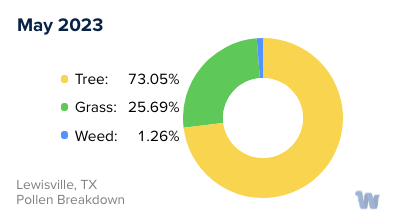
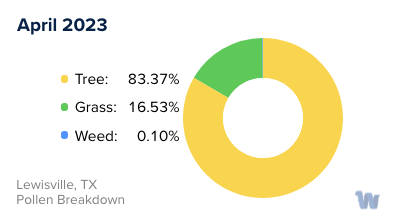
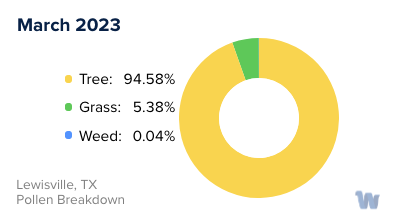

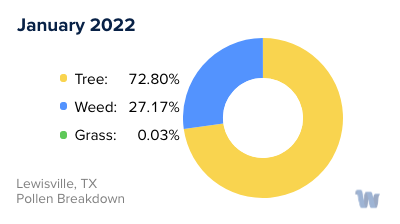

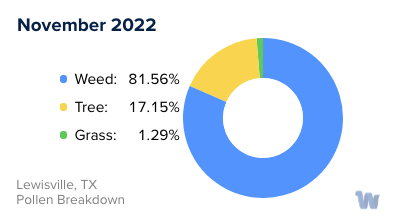
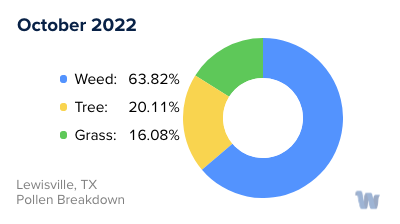


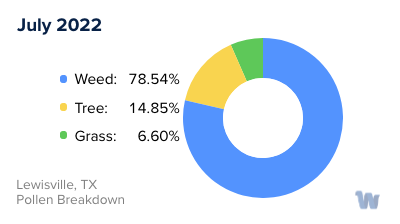
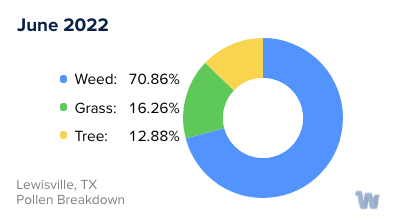
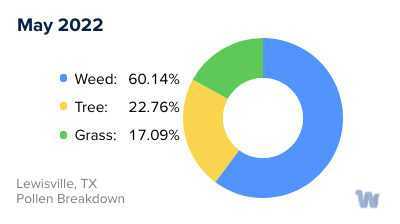


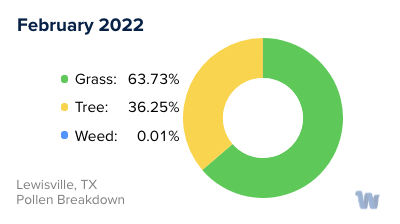
Pollen and Hay Fever in Lewisville, TX
Pollen allergies, also known as hay fever or allergic rhinitis, are a significant concern for residents of Lewisville, Texas. The primary producers of pollen in the area include a variety of grasses, trees, and weeds. The mix of allergens in the air varies with the seasons, but people may experience symptoms at any time of the year.
In terms of grasses, Bermuda grass, Timothy grass, and Sweet vernal grass are some of the most common culprits. Trees such as Oak, Elm, Ash, Pecan, Cottonwood, and especially Cedar, are significant contributors to the pollen count. Ragweed, a weed, is another common allergen in the region.
The timing of pollen release generally follows a cycle in Lewisville. Spring, summer, and fall are typically when pollen allergies are most likely to flare up. However, because of Texas's warm weather and the prevalence of certain types of pollen, such as that from the Cedar tree, Texans rarely get a break from their seasonal allergies. Even winter can pose challenges due to Cedar fever and indoor allergens.
It's crucial to be aware of the pollen count throughout the year, but especially in December, January, May, and September. These months are when seasonal allergies are typically at their peak. During these periods, the evening hours may offer some relief, as pollen counts tend to be lower at that time.
Understanding the types of pollen and their seasonal variations in Lewisville can help residents and visitors alike prepare for and manage their pollen allergies. It's part of living in this vibrant city and a small price to pay for the beauty of its natural environment.

